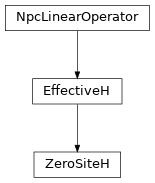ZeroSiteH
full name: tenpy.algorithms.mps_common.ZeroSiteH
parent module:
tenpy.algorithms.mps_commontype: class
Inheritance Diagram

Methods
|
|
Return the hermitian conjugate of self. |
|
|
Combine the legs of theta, such that it fits to how we combined the legs of self. |
|
|
|
Apply the effective Hamiltonian to theta. |
Contract self to a matrix. |
|
|
Equivalent to |
|
Equivalent to |
Class Attributes and Properties
- class tenpy.algorithms.mps_common.ZeroSiteH(env, i0)[source]
Bases:
EffectiveHClass defining the zero-site effective Hamiltonian for Lanczos.
The effective zero-site Hamiltonian looks like this:
| .--- ---. | | | | LP----------RP | | | | .--- ---.
Note that this class has less functionality than the
OneSiteHandTwoSiteH.- Parameters:
env (
MPOEnvironment) – Environment for contraction<psi|H|psi>.i0 (int) – Site index such that LP is everything strictly left of i0.
- acts_on
Labels of the state on which self acts. NB: class attribute. Overwritten by normal attribute, if combine.
- LHeff, RHeff
Only set if
combine, and only one of them depending onmove_right. If move_right was True, LHeff is set with labels'(vR*.p0)', 'wR', '(vR.p0*)'for bra, MPO, ket; otherwise RHeff is set with labels'(p0*.vL)', 'wL', '(p0, vL*)'- Type:
- LP, W0, RP
Tensors making up the network of self.
- Type:
- combine_theta(theta)[source]
Combine the legs of theta, such that it fits to how we combined the legs of self.
- update_LP(env, i, U=None)[source]
Equivalent to
env.get_LP(i, store=True); optimized for combine.- Parameters:
env (
MPOEnvironment) – The same environment as given during class initialization.i (int) – We update the part left of site i. Can optimize if i ==
i0andcombineis True.U (None |
Array) – The tensor on the left-most site self acts on, with combined legs after SVD. Only used if trying to optimize.
- update_RP(env, i, VH=None)[source]
Equivalent to
env.get_RP(i, store=True); optimized for combine.- Parameters:
env (
MPOEnvironment) – The same environment as given during class initialization.i (int) – We update the part right of site i. Can optimize if i ==
i0+ 2 -lengthandcombineis True.U (None |
Array) – The tensor on the right-most site self acts on, with combined legs after SVD. Only used if trying to optimize.